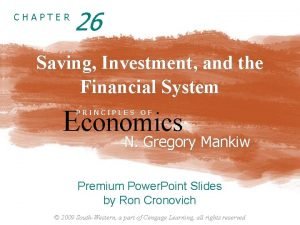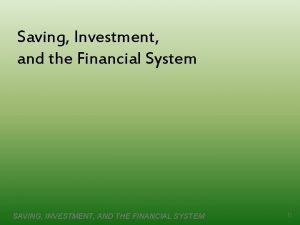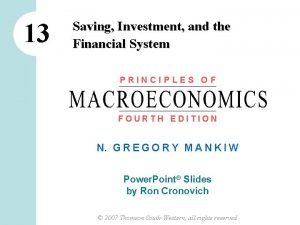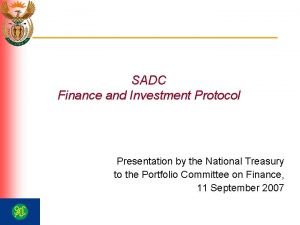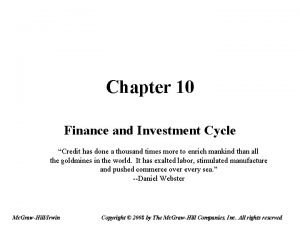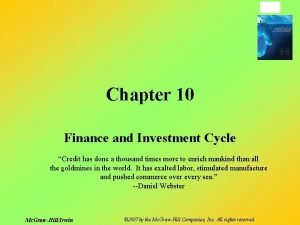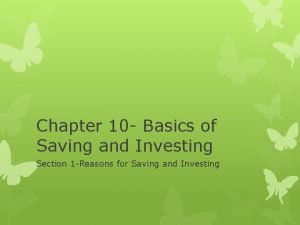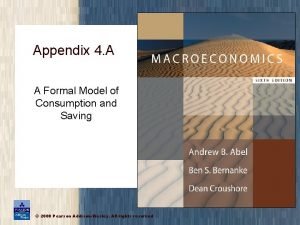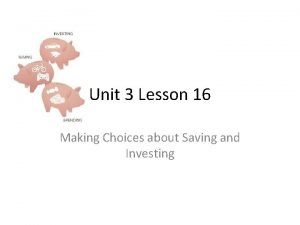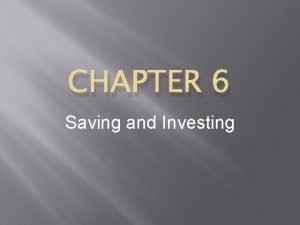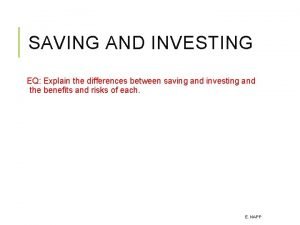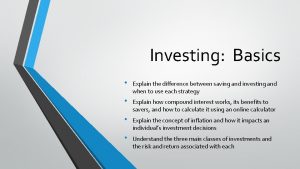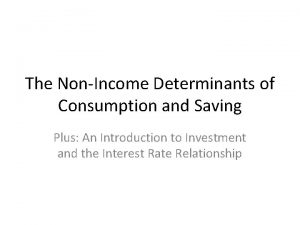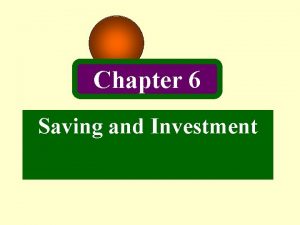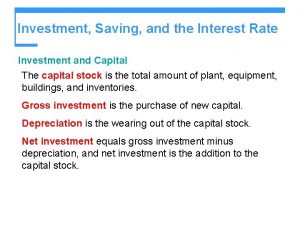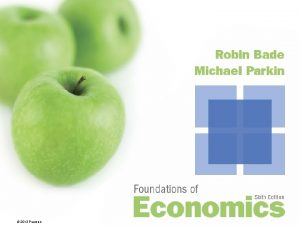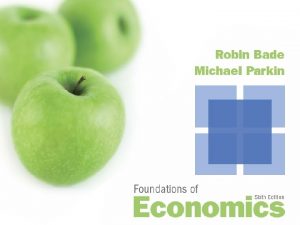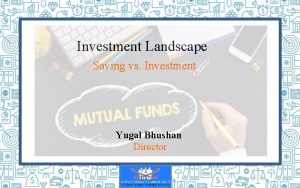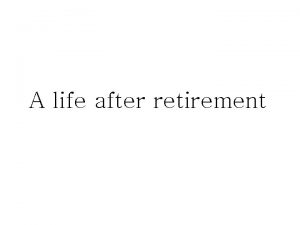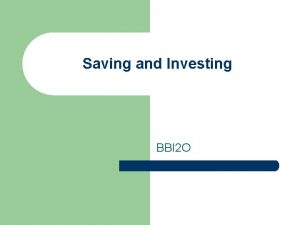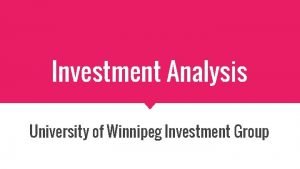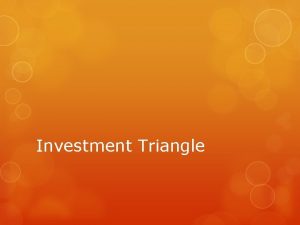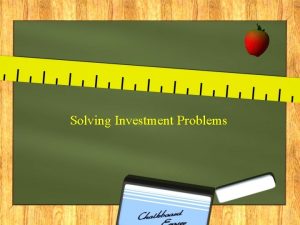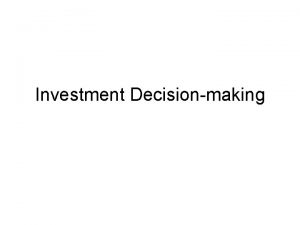7 FINANCE SAVING AND INVESTMENT After studying this




































- Slides: 36


7 FINANCE, SAVING, AND INVESTMENT

After studying this chapter, you will be able to: u Describe the flow of funds in financial markets u Explain how financial decisions are made and the risks that arise from these decisions u Explain how lending and borrowing decisions interact in financial markets u Explain how governments influence financial markets © 2019 Pearson Education

Financial Markets and Financial Institutions To study the economics of financial institutions and markets we distinguish between § Finance and money § Physical capital and financial capital Finance and Money The study of finance looks at how households and firms obtain and use financial resources and how they cope with the risks that arise in this activity. The study of money looks at how households and firms use it, how much of it they hold, how banks create and manage it, and how its quantity influences the economy. © 2019 Pearson Education

Financial Markets and Financial Institutions Capital and Financial Capital (or physical capital) is the tools, instruments, machines, buildings, and other items that have been produced in the past and that are used today to produce goods and services. The funds that firms use to buy physical capital are called financial capital. © 2019 Pearson Education

Financial Markets and Financial Institutions Capital and Investment Gross investment is the total amount spent on purchases of new capital and on replacing depreciated capital. Depreciation is the decrease in the quantity of capital that results from wear and tear and obsolescence. Net investment is the change in the quantity of capital. Net investment = Gross investment Depreciation. © 2019 Pearson Education

Financial Markets and Financial Institutions Figure 7. 1 illustrates the relationships among the capital, gross investment, depreciation, and net investment. © 2019 Pearson Education

Financial Markets and Financial Institutions Wealth and Saving Wealth is the value of all the things that people own. Saving is the amount of income that is not paid in taxes or spent on consumption goods and services. Saving increases wealth. Wealth also increases when the market value of assets rises—called capital gains—and decreases when the market value of assets falls—called capital losses. © 2019 Pearson Education

Financial Markets and Financial Institutions Financial Capital Markets Saving is the source of funds used to finance investment. These funds are supplied and demanded in three types of financial markets: § Loan markets § Bond markets § Stock markets © 2019 Pearson Education

Financial Markets and Financial Institutions A financial institution is a firm that operates on both sides of the markets for financial capital. It is a borrower in one market and a lender in another. Key financial institutions are § Commercial banks § Government-sponsored mortgage lenders § Mutual funds and Pension funds § Insurance companies §The Federal Reserve © 2019 Pearson Education

Financial Markets and Financial Institutions Funds that Finance Investment Funds come from three sources: 1. Household saving S 2. Government budget surplus (T – G) 3. Borrowing from the rest of the world (M – X) Figure 7. 2 on the next slide illustrates the flows of funds that finance investment. © 2019 Pearson Education

Financial Markets and Financial Institutions © 2019 Pearson Education

Financial Decisions and Risk Financial markets and institutions enable us to make decisions about the timing of our use of scarce resources, and to manage the risks that arise from these decisions. The Time Value of Money To compare current and future dollars, we convert future dollars, called “future value, ” to current dollars, called “present value. ” Present value of Future amount, n years in the future when the interest rate is r percent equals Future amount divided by (1 + r)n © 2019 Pearson Education

Financial Decisions and Risk Net Present Value Net present value is the present value of all the future flows of money that arise from a financial decision minus the initial cost of the decision. An example: Jack can make a game bot for $500 and sell it after two years for $2, 420. The interest rate is 10 percent a year. The present value of $2, 420 two years in the future is $2, 420 divided by (1 + 0. 1)2, which is $2, 000. The net present value of Jack’s bot equals $2, 000 – $500, or $1, 500. © 2019 Pearson Education

Financial Decisions and Risk Decision Rule The financial decision rule is: If the net present value is positive, do it! If the net present value is negative, don’t do it! Following this decision rule maximizes wealth when the future money flows are not risky. Where the future is uncertain, the rule is modified to: Do it if the net present value is large enough to make a loss sufficiently unlikely. © 2019 Pearson Education

Financial Decisions and Risk Financial Risk: Insolvency and Illiquidity A financial institution’s net worth is the total market value of what it has lent minus the market value of what it has borrowed. If net worth is positive, the institution is solvent and can remain in business. But if net worth is negative, the institution is insolvent and will go out of business. © 2019 Pearson Education

Financial Decisions and Risk Market Risk: Interest Rates and Asset Prices The interest rate on a financial asset equals the interest received expressed as a percentage of the price of the asset. For example, if the price of the asset is $50 and the interest is $5, then the interest rate is 10 percent. If the asset price rises (say to $200), other things remaining the same, the interest rate falls (2. 5 percent). If the asset price falls (say to $20), other things remaining the same, the interest rate rises (to 25 percent). © 2019 Pearson Education

Financial Decisions and Risk Getting Real An economy with inflation has two interest rates: The nominal interest rate and the real interest rate. The nominal interest rate is the number of dollars that a borrower pays and a lender receives in interest in a year expressed as a percentage of the number of dollars borrowed and lent. For example: If the annual interest paid on a $500 loan is $25, the nominal interest rate is 5 percent per year. © 2019 Pearson Education

Financial Decisions and Risk The real interest rate is the nominal interest rate adjusted to remove the effects of inflation on the buying power of money. The real interest rate is approximately equal to the nominal interest rate minus the inflation rate. For example: If the nominal interest rate is 5 percent a year and the inflation rate is 2 percent a year, the real interest rate is 3 percent a year. The real interest rate is the opportunity coast of borrowing. © 2019 Pearson Education

The Loanable Funds Market The market for loanable funds is the aggregate of all the individual financial markets. The market for loanable funds determines the real interest rate, the quantity of funds loaned, saving, and investment. We’ll start by ignoring the government and the rest of the world. The Demand for Loanable Funds The quantity of loanable funds demanded depends on 1. The real interest rate 2. Expected profit © 2019 Pearson Education

The Loanable Funds Market Demand for Loanable Funds Curve The demand for loanable funds is the relationship between the quantity of loanable funds demanded and the real interest rate when all other influences on borrowing plans remain the same. Business investment is the main item that makes up the demand for loanable funds. © 2019 Pearson Education

The Loanable Funds Market Figure 7. 3 shows the demand for loanable funds curve. A rise in the real interest rate decreases the quantity of loanable funds demanded. A fall in the real interest rate increases the quantity of loanable funds demanded. © 2019 Pearson Education

The Loanable Funds Market Changes in the Demand for Loanable Funds When the expected profit changes, the demand for loanable funds changes. Other things remaining the same, the greater the expected profit from new capital, the greater is the amount of investment and the greater the demand for loanable funds. © 2019 Pearson Education

The Loanable Funds Market The Supply of Loanable Funds The quantity of loanable funds supplied depends on 1. The real interest rate 2. Disposable income 3. Expected future income 4. Wealth 5. Default risk © 2019 Pearson Education

The Loanable Funds Market The Supply of Loanable Funds Curve The supply of loanable funds is the relationship between the quantity of loanable funds supplied and the real interest rate when all other influences on lending plans remain the same. Saving is the main item that makes up the supply of loanable funds. © 2019 Pearson Education

The Loanable Funds Market Figure 7. 4 shows the supply of loanable funds curve. A rise in the real interest rate increases the quantity of loanable funds supplied. A fall in the real interest rate decreases the quantity of loanable funds supplied. © 2019 Pearson Education

The Loanable Funds Market Changes in the Supply of Loanable Funds A change in disposable income, expected future income, wealth, or default risk changes the supply of loanable funds. An increase in disposable income, a decrease in expected future income, a decrease in wealth, or a fall in default risk increases saving and increases the supply of loanable funds. © 2019 Pearson Education

The Loanable Funds Market Equilibrium in the Loanable Funds Market The loanable funds market is in equilibrium at the real interest rate at which the quantity of loanable funds demanded equals the quantity of loanable funds supplied. © 2019 Pearson Education

The Loanable Funds Market Figure 7. 5 illustrates the loanable funds market. At 7 percent a year, there is a surplus of funds and the real interest rate falls. At 5 percent a year, there is a shortage of funds and the real interest rate rises. Equilibrium occurs at a real interest rate of 6 percent a year. © 2019 Pearson Education

The Loanable Funds Market Changes in Demand Supply Financial markets are highly volatile in the short run but remarkably stable in the long run. Volatility comes from fluctuations in either the demand for loanable funds or the supply of loanable funds. These fluctuations bring fluctuations in the real interest rate and in the equilibrium quantity of funds lent and borrowed. They also bring fluctuations in asset prices. © 2019 Pearson Education

The Loanable Funds Market Figure 7. 6(a) illustrates an increase in the demand for loanable funds. An increase in expected profits increases the demand for funds today. The real interest rate rises. Saving and quantity of funds supplied increases. © 2019 Pearson Education

The Loanable Funds Market Figure 7. 6(b) illustrates an increase in the supply of loanable funds. If one of the influences on saving plans changes and saving increases, the supply of funds increases. The real interest rate falls. Investment increases. © 2019 Pearson Education

Government in the Loanable Funds Market Government enters the loanable funds market when it has a budget surplus or deficit. § A government budget surplus increases the supply of funds. § A government budget deficit increases the demand for funds. © 2019 Pearson Education

Government in the Loanable Funds Market Figure 7. 7 illustrates the effect of a government budget surplus. A government budget surplus increases the supply of funds. The real interest rate falls. Private saving decreases. Investment increases. © 2019 Pearson Education

Government in the Loanable Funds Market Figure 7. 8 illustrates the effect of a government budget deficit. A government budget deficit increases the demand for funds. The real interest rate rises. Private saving increases. Investment decreases—is crowded out. © 2019 Pearson Education

Government in the Loanable Funds Market Figure 7. 9 illustrates the Ricardo-Barro effect. A budget deficit increases the demand for funds. Rational taxpayers increase saving, which increases the supply of funds. Increased private saving finances the deficit. Crowding-out is avoided. © 2019 Pearson Education
 Chapter 26 saving investment and the financial system
Chapter 26 saving investment and the financial system What is national savings
What is national savings Saving investment and the financial system
Saving investment and the financial system After me after me after me
After me after me after me If any man comes after me
If any man comes after me Fixed investment and inventory investment
Fixed investment and inventory investment Sadc protocol on finance and investment
Sadc protocol on finance and investment Finance and investment cycle
Finance and investment cycle Finance and investment cycle
Finance and investment cycle Corporate finance vs investment banking
Corporate finance vs investment banking How did the english finance their colonies after 1606?
How did the english finance their colonies after 1606? Module 11 studying the brain
Module 11 studying the brain Chapter 2 lesson 1 studying geography
Chapter 2 lesson 1 studying geography Section 1 studying viruses and prokaryotes
Section 1 studying viruses and prokaryotes Lesson twelve saving and investing
Lesson twelve saving and investing Examples of labour saving devices in the kitchen
Examples of labour saving devices in the kitchen Chapter 10 basics of saving and investing
Chapter 10 basics of saving and investing Holding a variety of investments to reduce risk
Holding a variety of investments to reduce risk The life-cycle model of consumption and saving
The life-cycle model of consumption and saving Lesson 16-2 saving and investing answer key
Lesson 16-2 saving and investing answer key Heat transfer grade 7
Heat transfer grade 7 Chapter 6 saving and investing
Chapter 6 saving and investing Explain the investment poem concerning stocks and bonds.
Explain the investment poem concerning stocks and bonds. Saving vs investing venn diagram answers
Saving vs investing venn diagram answers Non income determinants of consumption and saving
Non income determinants of consumption and saving Researchers who are studying a new shampoo formula
Researchers who are studying a new shampoo formula Importance of studying population
Importance of studying population Job evaluation point method example
Job evaluation point method example Jummah sunnah rakat
Jummah sunnah rakat Studying in sweden as an eu citizen
Studying in sweden as an eu citizen Studying our living planet
Studying our living planet A student is studying the ecology of a playa lake
A student is studying the ecology of a playa lake Chapter 24 studying the sun
Chapter 24 studying the sun The five i's of studying microorganisms
The five i's of studying microorganisms What do global ecologists study
What do global ecologists study Objectives of studying juvenile delinquency
Objectives of studying juvenile delinquency When criticizing functional objects
When criticizing functional objects
